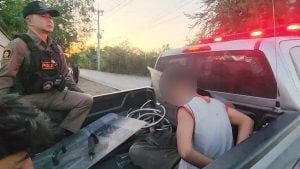Gardening: Choosing the right insecticide

PHUKET: A good friend, Graham, an airline captain, asks “Can you recommend an all-round weed-killer, not for the garden but for the grass and weeds out in the road by my house?” He adds: “For the last two months, we have fed the pretty caterpillar population (green with blue eyes) and love the butterflies into which they develop, but we now feel we have fulfilled our obligation to nature and would like to know if there is a spray we can use, if only to persuade the butterflies to move into the next garden.”
As well as possessing a mischievous sense of humor and a wonderful villa, perched high above Kata with spectacular sea views, Graham and his charming wife, Mo, clearly have the right instincts about Mother Nature.
Since the weeds include grass and are not in Graham’s garden, I would advise the use of a non-selective weed-killer. Two that are widely employed here (although you will need to check the label) are paraquat (manufactured by Syngenta) and the much more recently developed Roundup (Monsanto). Both are contact herbicides that work by killing first the foliage and then the roots of affected weeds.
Personally, I would always prefer to use paraquat since it is deactivated once it makes contact with the soil, and leaves no toxic residues in run-off or ground water. Typically, it is diluted 50 to 100 fold in water before application. Roundup is fiercely effective stuff and remains active for a whole year, but there is growing evidence that the chemical (glyphosate) can cause limited environmental damage. Neither of them pose any threat to pets.
As for your caterpillar problem, you deserve a pat on the back for your forbearance. They are probably the larvae of the splendid oleander hawk moth, and while you don’t specify which shrubs they are molesting, I would guess either adeniums (which have few enough leaves anyway), tabernaemontanas or oleanders. Personally, I remove the sprig on which they are feeding, and throw them over the wall, but they are voracious feeders and I recognize the need for more drastic action. In any case the critters are perfectly camouflaged for their environment and hide under the leaves. So, even with the eagle eyes of a pilot, they are difficult to spot.
A systemic insecticide, which is watered in at the roots and spreads throughout the foliage is therefore – if you will pardon the pun – the obvious solution. But, while the horror chemicals – organochlorides such as DDT, dieldrin and chlordane – are now banned, the newer compounds such as carbaryl, while not retained in the food chain, still kills beneficial insects such as bees.
Alternative ‘natural’ or organic pesticides – which I would strongly advocate using – include those based on nicotine, pyrethrum and neem (a local tree) that are all produced by the plant in question (tobacco, aster or neem) to counter the munching habits of insects. Just as your toxic caterpillars protect themselves from predators because they feed on poisonous plants, so your neem and nicotine plants safeguard themselves by producing insect repellents.
If you have gardening or environmental concerns, contact Patrick at drpaccampbell@gmail.com. Many of his creative and academic publications can be found at his website: Green galoshes WordPress.
— Patrick Campbell
Latest Thailand News
Follow The Thaiger on Google News:


























